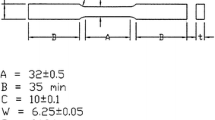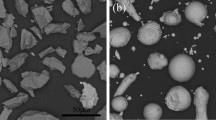Abstract
The aircraft industry is always looking for improved efficiency through higher in-service engine temperatures and lighter structures. Titanium-based alloys are good candidates for such applications because of their high specific strength. However, when exposed to high-temperature oxidizing environments, a large amount of dissolved oxygen can be found in such alloys beneath the growing oxide scale, possibly leading to embrittlement. Consequently, evaluating the oxidation resistance of these alloys is essential. With this aim, long-term oxidation tests were carried out on Ti6242S alloy between 500 and 650 °C to study the effect of temperature, surface preparation and microstructure on oxide scale and oxygen dissolution. While increasing the temperature from 560 to 625 °C led to accelerated oxidation kinetics, surface preparation had no noticeable effect on mass variations and oxygen diffusion profiles. Regarding microstructure, when comparing Ti6242S samples having similar α-phase fraction but very different microstructures (fineness and morphology), there wasn’t any significant effect found on mass change and oxygen diffusion after 1 kh at 650 °C.








Similar content being viewed by others
References
J. L. Murray and H. A. Wriedt, Bulletin of Alloy Phase Diagrams 8, 148–165 (1987).
W. L. Finlay and J. A. Snyder, Journal of Metals 188, 227–286 (1950).
H. Fukai, et al., Isij International 45, 133–141 (2005).
A. Casadebaigt, D. Monceau, and J. Hugues, MATEC Web of Conferences, The 14th World Conference on Titanium (Ti 2019), Vol. 321, 03006 (2020).
A. Vande Put et al., MATEC Web of Conferences, The 14th World Conference on Titanium (Ti 2019), Vol. 321, 04011 (2020).
B. Champin, et al., Journal of the Less Common Metals 69, 163–183 (1980).
A. Casadebaigt, J. Hugues, and D. Monceau, Oxidation of Metals 90, 633–648 (2018).
M. Wen, et al., Colloids and Surfaces B-Biointerfaces 116, 658–665 (2014).
A. Kanjer, et al., Oxidation of Metals 88, 383–395 (2017).
A. Kanjer, et al., Surface and Coatings Technology 343, 93–100 (2018).
M. Thomas, et al., Acta Materialia 60, 5040–5048 (2012).
L. Lavisse et al., Surface & Coatings Technology 403, 126368 (2020).
K. Calvert and Y. Kosaka, Evaluation of titanium alloys after high temperature air exposure, Proceedings of 13th World Conference on Titanium, pp. 1605–1612 (2016).
M. Berthaud, et al., Corrosion Science 164, 108049 (2020).
R. Gaddam, et al., Materials Characterization 99, 166–174 (2015).
J. W. Elmer, et al., Materials Science and Engineering: A 391, 104–113 (2005).
A. Casadebaigt, J. Hugues, and D. Monceau, Corrosion Science 175, 108875 (2020).
K. V. Sai Srinadh and V. Singh, Bulletin of Materials Science 27, 347–354 (2004).
C. Leyens, et al., Materials Science and Technology 12, 213–218 (1996).
F. Pitt and M. Ramulu, Journal of Materials Engineering and Performance 13, 727–734 (2004).
D. P. Satko, et al., Acta Materialia 107, 377–389 (2016).
C. J. Rosa, Metallurgical Transactions 1, 2517–2522 (1970).
T. Sugahara et al., The Effect of Widmanstatten and Equiaxed Microstructures of Ti-6Al-4V on the Oxidation Rate and Creep Behavior, Materials Science Forum, Vol. 636–637, pp. 657–662 (2010).
N. Vaché, et al., Corrosion Science 178, 109041 (2021).
C. Ciszak, et al., Corrosion Science 176, 109005 (2020).
Acknowledgements
This study on the effect of microstructure was supported by the French National Research Agency through the project ANR DUSTI in partnership with Airbus, Airbus Group Innovations, Aubert&Duval, Liebherr Toulouse Aerospace, the Institut Pprime, the Institut Jean Lamour and the CIRIMAT Laboratory. The contributions of Moukrane Dehmas through fruitful discussions are gratefully acknowledged.
Author information
Authors and Affiliations
Corresponding author
Additional information
Publisher's Note
Springer Nature remains neutral with regard to jurisdictional claims in published maps and institutional affiliations.
Rights and permissions
About this article
Cite this article
Vande Put, A., Dupressoire, C., Thouron, C. et al. High-Temperature Oxidation Behavior of Ti6242S Ti-based Alloy. Oxid Met 96, 373–384 (2021). https://doi.org/10.1007/s11085-021-10073-4
Received:
Revised:
Accepted:
Published:
Issue Date:
DOI: https://doi.org/10.1007/s11085-021-10073-4




